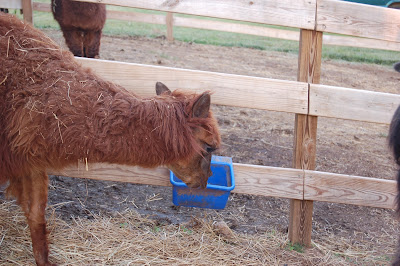Hot Reggae is an alpaca who was born in 1994 in the Pacific Northwest. He was the cria of an alpaca who was owned and bred by two vets in a very large operation. By the time of his birth he was owned by a dentist and his wife who also lived in the Pacific Northwest. Hot Reggae accompanied two other alpacas we purchased from them in March of 2000. Hot Reggae made the long trip from the Pacific Northwest to Virginia in the air conditioned horse trailer that people in the alpaca trade call "The Alpaca Train". He arrived to us with Mr. Ditto Two and Noche Buena. Hot Reggae was a gelded male, but he had a very important job within the herd. He was the lookout, the security officer and the alpaca policeman, not only when the herd consisted only of three, but later when others were born, or added through additional purchases.
Alpacas are very much herd animals. The herd is a family to them, and when one dies, there is a grieving period. They are more loving and more empathetic than most realize. While protecting the herd and notifying us of marauding dogs and coyotes, he also grieved and supported grieving when Shakria, our first cria died when just a few days old. He also supported the herd when Shakria's mother eventually died of astrocytoma. He oversaw and participated in alpaca soccer tournaments until the farm vet put a stop to the practice saying that it could lead to a potentially fatal broken leg. Then, he became part of the tetherball alpaca league. He also dutifully listened as our children learned to play a variety of musical instruments. The Irish whistle and the uileann pipes are the two I remember that he seemed to enjoy best. I also remember his placing his chin on my shoulder as I sat on the stump within the alpaca pen and cried when I heard that my aunt had died.
In 2004, we moved all of the alpacas to a new farm we built where they would have much better accommodations. Hot Reggae never seemed all that impressed. All he ever really seemed to need was his herd, some green grass, some good hay in winter, a handful of Mazuri pelleted alpaca feed per day, and lots of fresh water. He tolerated shearing as if he understood. We never really needed to trim his nails much because he used to file them down himself on a sharp rock in the pen. He seemed to stop, as if it were a secret, each time he realized that we were watching.
Alpacas have a stated lifespan of about fifteen years, however in captivity and with good care, some individuals have lived much longer. As they have aged, we have developed additional habits which have kept them healthy and living longer. Normally, We add zinc to their feed. We continue injections to prevent meningeal worm. They receive an annual rabies and CDT shot. With age, we give occasional thiamine and vitamin A,C, and D, shots. We drop selenium tablets in their pellets
In the past year, we knew that Reggae, as well as his dear friend Mr. Ditto II, were failing. Neither were moving particularly well. Hot Reggae seemed to have a stiff neck. Their tolerance for heat was also not what it once had been. We made sure they had extra water and we added fans suspended to the rafters from their now shared concrete floored barn room. When the weather was hotter than 90 degrees F, then we would spray them down with cool water particularly on the legs and underbelly which is where they dissipate heat.
At the end of July, both Mr. Ditto Two and Hot Reggae were illl. Both seemed to have pneumonia to me. I treated both with an appropriate dose of Tylosin intramuscularly over several days. I also gave multiple injections of thiamine. Hot Reggae rallied and seemed to recover. Ditto died peacefully at the end of July, this year, at age 20.
We knew that Hot Reggae, though he appeared completely recovered, was living on borrowed time. He was now 22 years old ! He simply appeared not to want to leave his herd, and the human family who had loved him for all this time, right on top of Ditto's loss. So he hung in there with us.
This morning, he seemed congested again. I gave another injection of Tylosin. He drank some water and ate all the pelleted grain in his dish. Then, he grazed in his pen with his nephew, Chocolat, while I moved four horses out to graze. He appeared all right, and yet I knew that we wouldn't have much longer together.
When I returned from lunch to top up waters and to check on him, he had passed quite recently. He was lying in the stall on his side under the fans on the cool concrete floor, his eyes still open. I imagine that it had been just moments ago because as I wrapped him for burial, rigor mortis had not yet set in.
Today, Reggae joins a herd of alpacas who were all loved here. It is my hope that Daniel will look after them until we get there to, once again, help with the task. It has been my honor and privilege to know you and to care for you while you were here, Reggae. I will do my best to ensure health and safety for the remaining herd. And of course you know, you will be sorely missed. We will meet again, my friend.
 |
| A kind and gentle animal who was always the protector and the "police officer" of the herd. |




